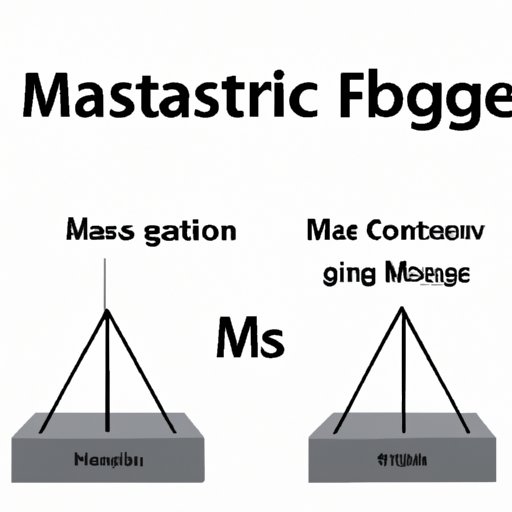
Is Mass and Weight the Same?
There is often confusion between the concepts of mass and weight as these terms are sometimes used interchangeably. However, these two concepts are not the same and understanding the differences between them is crucial.
Mass and Weight: Understanding the Basic Differences
Mass is defined as the amount of matter that an object contains. It is an inherent property of an object. Weight, on the other hand, is a measure of the gravitational force that an object experiences due to its mass. It varies with the location and the strength of the gravitational field it is subjected to.
For example, the mass of an object remains the same on Earth and in outer space, but its weight on Earth is different from its weight in outer space. The weight of an object is proportional to the amount of gravitational force it experiences at its location.
Exploring the Science of Mass vs Weight
Mass and weight have a fundamental relationship in physics. The weight of an object is calculated as the product of mass and acceleration due to gravity. This relationship is described by the following equation:
Weight = Mass x Acceleration due to gravity
The standard unit of mass is kilograms, and the unit of weight is newtons. The acceleration due to gravity is approximately 9.8 meters per second-square on Earth’s surface.
To understand the difference between mass and weight better, perform simple experiments. For example, compare the mass of an object on a weighing scale on Earth’s surface and in outer space. You will notice that the mass remains the same, while the weight in outer space will be zero as no gravitational force is acting on the object.
Mass and weight have a crucial role in science and industry. For example, the mass of a substance is a fundamental parameter that is used to calculate its quantities in chemical reactions. The weight of a load is an important factor in the transport and shipping industry, and it determines the cost of transportation.
Why Knowing the Difference Between Mass and Weight Matters
Understanding the distinctions between mass and weight is essential in various aspects of everyday life and work. Knowledge of these concepts can help in:
- Calculating dosages of medication or chemicals
- Determining the nutritional value of food
- Choosing the right size of clothing
- Controlling the quantity of materials in manufacturing processes
- Estimating the loads in construction work, and much more.
For instance, imagine you are a pharmacist and must calculate the dosage of a medication for a patient. The dosage is prescribed based on the patient’s mass, not their weight. Therefore, if you mistake weight for mass, you will administer the wrong amount of medication, which can cause severe consequences for the patient.

Mass vs. Weight: Common Misconceptions Debunked
Many misconceptions exist about mass and weight. One common misunderstanding is that they are the same. Another misconception is that weight and mass are affected by the size of an object. However, the size of an object has no direct impact on its mass or weight.
To differentiate between mass and weight, consider the following: mass is an intrinsic property of matter and does not change. In contrast, weight is a force that changes depending on the gravitational force acting on the object.
Mass and Weight in Physics: From Theory to Application
The physics behind mass and weight is fundamental to science. Knowledge of mass and weight can help us solve complex problems in many scientific fields such as engineering, chemistry, and physics.
A real-world application of mass and weight is the design of airplanes. The weight of an aircraft determines how much lift it needs to generate to get off the ground. Therefore, engineers and physicists use the knowledge of mass and weight to design planes that can achieve the necessary lift.
The Effect of Gravity on Mass and Weight: A Comprehensive Guide
Gravity plays a crucial role in the measurement of mass and weight. The gravitational force is responsible for giving weight to an object and is directly proportional to the mass of the object.
For instance, the weight of an object on the surface of the Earth is greater than its weight on the surface of the Moon because Earth has a stronger gravitational force than the Moon. Therefore, an object with a mass of 50 kilograms weighs approximately 490 Newtons on Earth but weighs only 80 Newtons on the Moon.
Mass and Weight Conversion Made Easy
Converting between mass and weight is simple as long as you know the appropriate formula and units of measurement. The conversion between these two concepts requires knowledge of the gravitational acceleration at the particular location you are measuring.
Here are the formulas and units to help you convert between mass and weight:
- Conversion of Mass to Weight: Weight = Mass x Gravitational Acceleration
- Conversion of Weight to Mass: Mass = Weight / Gravitational Acceleration
- The standard unit of mass is kilograms, and the unit of weight is newtons.
Conclusion
In conclusion, mass and weight are often interchangeably used, but they have distinct meanings in physics and everyday life. Understanding the difference between mass and weight is essential in applications across many fields.
Knowing how to differentiate between mass and weight and how to measure them correctly is crucial in solving real-world problems. The physics behind mass and weight is fundamental for many scientific disciplines, and the concepts of mass and weight are instrumental in solving problems in many industries.





